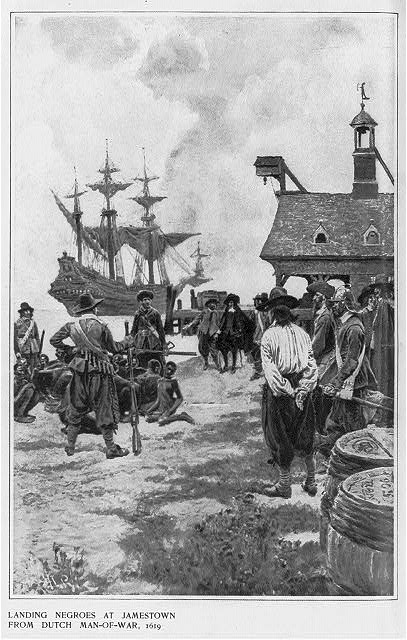|
Lumpkin's Slave Jail
Lumpkin's Jail, also known as "the Devil's half acre", was a slave breeding farm, as well as a holding facility, or slave jail, located in Richmond, Virginia, just three blocks from the state capitol building. More than five dozen firms traded in enslaved human beings within blocks of Richmond's Wall Street (now 15th Street) between 14th and 18th Streets between the 1830s and the end of the American Civil War. Its final and most notorious owner, Robert Lumpkin, bought and sold slaves throughout the South for well over twenty years, and Lumpkin's Jail became Richmond's largest slave-holding facility. History Robert Lumpkin purchased three lots on Wall Street in Shockoe Bottom (named for nearby Shockoe Creek) on November 27, 1844, for roughly six thousand dollars. Although named after Lumpkin, the property had two previous owners, and the holding facility already existed. Lumpkin was also involved in the slave trade at the Birch Alley facility in Richmond. Not only the larges ... [...More Info...] [...Related Items...] OR: [Wikipedia] [Google] [Baidu] |
Anthony Burns
Anthony Burns (May 31, 1834 – July 17, 1862) was an African-American man who escaped from slavery in Virginia in 1854. His capture and trial in Boston, and transport back to Virginia, generated wide-scale public outrage in the North and increased support for abolition. Burns was born enslaved in Stafford County, Virginia. As a young man, he became a Baptist and a "slave preacher" at the Falmouth Union Church in Falmouth, Virginia. He was frequently hired out by his master and learned to read and write in his various assignments. In 1853, he escaped from slavery and reached the free state of Massachusetts. He started working in Boston. The following year, he was captured under the Fugitive Slave Act of 1850 and tried in court in Boston. The Fugitive Slave Act was despised and fiercely resisted in Boston, and Burns's case attracted national publicity, including large demonstrations, protests, attacks, and violence. Federal troops were used in the city to ensure Burns was trans ... [...More Info...] [...Related Items...] OR: [Wikipedia] [Google] [Baidu] |
History Of Slavery In Virginia
Slavery in Virginia began with the capture and enslavement of Native Americans during the early days of the English Colony of Virginia and through the late eighteenth century. They primarily worked in tobacco fields. Africans were first brought to colonial Virginia in 1619, when 20 Africans from present-day Angola arrived in Virginia aboard the ship '' The White Lion''. As the slave trade grew, enslaved people generally were forced to labor at large plantations, where their free labor made plantation owners rich. Colonial Virginia became an amalgamation of Algonquin-speaking Native Americans, English, other Europeans, and West Africans, each bringing their own language, customs, and rituals. By the eighteenth century, plantation owners were the aristocracy of Virginia. There were also a class of white people who oversaw the work of enslaved people, and a poorer class of whites that competed for work with freed blacks. Tobacco was the key export of the colony in the sevente ... [...More Info...] [...Related Items...] OR: [Wikipedia] [Google] [Baidu] |
African-American History In Richmond, Virginia
African Americans, also known as Black Americans and formerly also called Afro-Americans, are an American racial and ethnic group that consists of Americans who have total or partial ancestry from any of the Black racial groups of Africa. African Americans constitute the second largest ethno-racial group in the U.S. after White Americans. The term "African American" generally denotes descendants of Africans enslaved in the United States. In 2023, an estimated 48.3 million people self-identified as Black, making up 14.4% of the country’s population. This marks a 33% increase since 2000, when there were 36.2 million Black people living in the U.S. African-American history began in the 16th century, with Africans being sold to European slave traders and transported across the Atlantic to the Western Hemisphere. They were sold as slaves to European colonists and put to work on plantations, particularly in the southern colonies. A few were able to achieve freedom through ... [...More Info...] [...Related Items...] OR: [Wikipedia] [Google] [Baidu] |
Slave Jails In The United States
Slave markets and slave jails in the United States were places used for the slave trade in the United States from the founding in 1776 until the total abolition of slavery in 1865. ''Slave pens'', also known as slave jails, were used to temporarily hold enslaved people until they were sold, or to hold fugitive slaves, and sometimes even to "board" slaves while traveling. Slave markets were any place where sellers and buyers gathered to make deals. Some of these buildings had dedicated slave jails, others were ''negro marts'' to showcase the slaves offered for sale, and still others were general auction or market houses where a wide variety of business was conducted, of which "negro trading" was just one part. The term ''slave depot'' was commonly used in New Orleans in the 1850s. Slave trading was often done in business clusters where many trading firms operated in close proximity. Such clusters existed on specific streets (such as Pratt Street in Baltimore, Adams Street in Memph ... [...More Info...] [...Related Items...] OR: [Wikipedia] [Google] [Baidu] |


